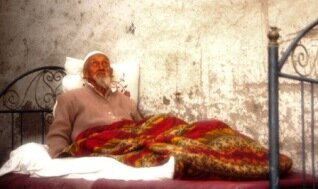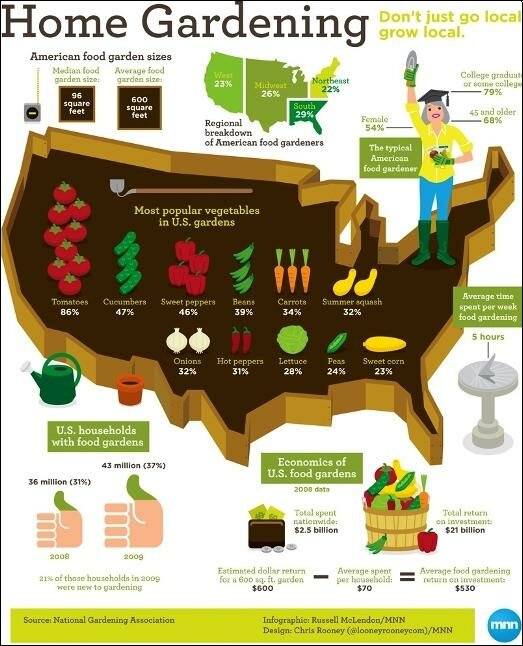Home Grown Vegetables
Today and 1000 years ago!
Here's a map of the USA showing the home gardening areas in 2011. Below the map we can read a brief outline of what home growing was like 1000 years ago in a different part of the world — England, along with their customs and folklore.
Click map for enlarged view
And in England a millenium ago, here's some excerpts from a book I've been reading called "The Year 1000" by Robert Laceys:
The fruits and vegetables were certainly more tasty than modern equivalents, but like the livestock of the year 1000, they were considerably smaller — as archaeologists have discovered from the pips and seeds found in ancient sites.
Several staples that we take for granted in our modern diet, were absent back then. There was no spinach, until seeds were brought back from the Crusades in the twelfth century.
Broccoli, cauliflower, runner beans, and brussels sprouts were all developed in later centuries by subsequent generations of horticulturalists.
Nor were there any potatoes or tomatoes. Europe had to wait five centuries for those, until the exploration of the Americas, and though the recipe books describe warm possets and herbal infusions, there were none of the still-to-be-imported stimulants--tea, coffee, or chocolate.
No sugar, and honey was so precious, that people paid taxes with it. It was a lucky day when a swarm of bees settled in your thatched hut.
Anglo-Saxon skeletal remains are remarkable for the relative absence of dental and jaw decay. Another source of sweetness was the crushed pulp of grapes left over from winemaking.
It was a warmer world then, and vineyards were plentiful, and in England the Normans' Domesday survey of 1086 listed at least thirty-eight vineyards. From 950 to 1300 temperatures were markedly warmer, even by today's age of "global warming." Meteorologists describe this medieval warm epoch as the "Little Optimum." London for example was up to 4 degrees Fahrenheit warmer.
Weather was a subject of intense interest...
"In May, thunder presages a hungry year...
In the month of July, thunder signifies crops turning out well, and livestock perishing...
If it thunders on Sunday, this is considered to presage an extensive mortality of monks and nuns...
Of thunder on Wednesday, there is no doubt that it presages the death of idle and scandalous prostitutes."
Anglo-Saxon charms were literally charming, and straight from nature.
- One cure for a headache involved binding the stalk of the herb crosswort to the head with a red bandana, while chilblains were to be treated with a mixture of eggs, wine, and fennel root.
- The yellow-glowered herb, agrimony, when boiled in milk, was guaranteed to excite the man who was "insufficiently virile", and if boiled in Welsh ale, agrimony had the opposite effect.
- For shingles, they took the bark of fifteen different trees, including apple and even olive - such an exotic tree that came from Lombady in the Mediterranean, and packed into the English traders saddlebags along with pepper and spices.
- Hallucinogenic potions were popular, mainly for their palliative psychedelic properties. Not exactly using Shakespeare's "skin of the frog" in much later years, but still, spider bite could be cured with fried and crushed black snails; lower-back pain was said to respond to the smoke of smouldering goat's hair, while baldness could certainly be removed by applying an ointment from the ashes of burned bees.
- Modern medicine has failed to proven any medical significance, but at the same time here we are in this day and age with some people believing in rhinoceros horn and bears paw.
- Here's a particularly well-balanced combination of folk remedy, religious conviction, and tender loving care — which was probably the most useful. "Take a bramble of which both ends are in the earth, take the newer root, dig it up, and cut nine chips on your left hand, then sing three times: Miserere mei deus [Psalm 56] and nine times the Our Father. Take then mugwort and everlasting and boil these three in several kinds of milk until they become red.

Let him then sup a good bowlfull of it, fasting at night, sometime before he takes other food. Make him rest in a soft bed and wrap him up warm.
-
MORE Articles on Sustainable Gardening and other Natural Living Ideas.






